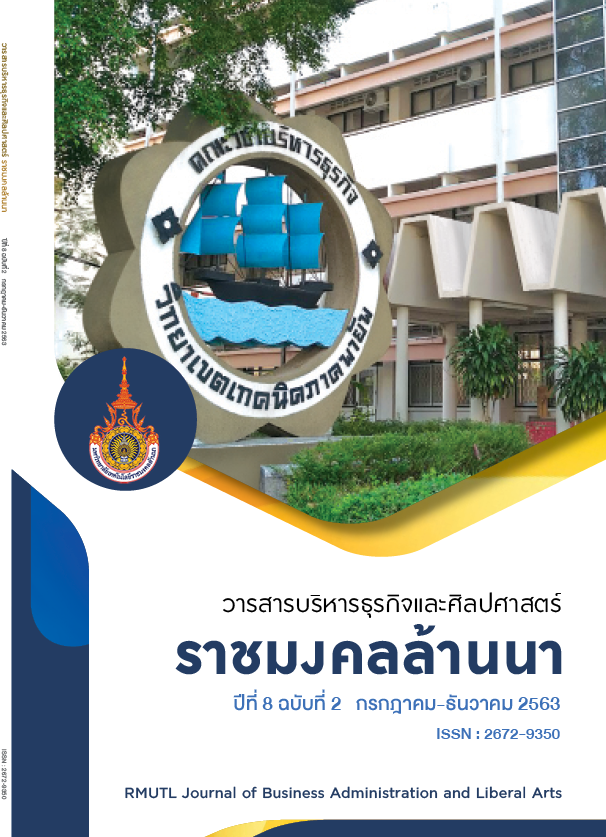Factors affecting the value of rice exports in the Chinese market
Main Article Content
Abstract
This study aims to examine the factors affecting the value of rice exports in the Chinese market. The factor consists of the consumer price index, temperature, rainfall, and exchange rates. The study period is from January 2008 to September 2019 in a monthly basis. The results from the prediction of the value of rice exports in the Chinese market could be benefit for planning, finding solutions, and preventing possible problems to those involved in rice exports to increase their revenue. From the multiple regression analysis, it shows consumer price index and rainfall could affect the value of rice exports in the Chinese market with statistical significance at the level of confidence at 95 percent. The exchange rate and temperature, however, does not have any effect on the value of rice exports in the Chinese market.
Article Details
บทความวิจัยนี้เป็นของลิขสิทธิ์
References
กรมการข้าว ศูนย์เมล็ดพันธุ์ข้าวขอนแก่น. (2562). ปัจจัยที่มีผลต่อการเจริญเติบโตของข้าว. สืบค้น 20 พฤศจิกายน 2562, จาก http://kknrsc.ricethailand.go.th/index.php/e-library/field/565-rice-growth-factor.
กรมอุตุนิยมวิทยา. (2562). สถิติปริมาณน้ำฝนและอุณหภูมิ ปี 2551-2562. สืบค้น 20 พฤศจิกายน 2562, จาก https://www.tmd.go.th/index.php.
การค้าไทย. (2562). มูลค่าการส่งออกสินค้าเกษตรย้อนหลังและอันดับสินค้าเกษตรที่ส่งออกมากที่สุด 10 อันดับปี 2561 ถึง ปี 2562. สืบค้น 20 พฤศจิกายน 2562, จาก http://tradereport.moc.go.th/DashBoard/Default.aspx
การค้าไทย. (2562). สถิติส่งออกข้าวในตลาดประเทศจีนของไทยปี 2551-2562. สืบค้น 20 พฤศจิกายน 2562, จาก http://www.ops3.moc.go.th
ธนาคารแห่งประเทศไทย. (2561). รายงานสินค้าเกษตรที่สำคัญของไทยไตรมาสที่ 2/2561. สืบค้น 20 กุมภาพันธ์ 2562, จาก https://www.bot.or.th/Thai/MonetaryPolicy/Northern/Commodities/North_Agri_2/Q2_61_CommodityReport.pdf
ธนาคารแห่งประเทศไทย. (2562). รายงานนโยบายการเงิน. สืบค้น 20 พฤศจิกายน 2562, จาก https://www.bot.or.th/Thai/MonetaryPolicy/MonetPolicyComittee/MPR/DocLib/MPRThai_June2562_63ito87.pdf
พิมพกานต์ พุทธศิริ. (2560). ปัจจัยที่มีผลกระทบต่อราคาข้าวเปลือกหอมมะลิในประเทศไทย(การค้นคว้าอิสระ บริหารธุรกิจมหาบัณฑิต). กรุงเทพมหานคร: มหาวิทยาลัยกรุงเทพ.
มติชนออนไลน์. (2562). ไทยติด Top 10 ผู้ส่งออกสินค้าเกษตรโลก. สืบค้น 20 พฤศจิกายน 2562, จาก https://www.matichon.co.th/newsmonitor/news_1689529
รุ่งทิวา ไพรบึง. (2561). การศึกษาปัจจัยที่มีอิทธิพลต่อราคาข้าวหอมมะลิ. วารสารวิชาการวิทยาศาสตร์ มหาวิทยาลัยราชภัฏจันทรเกษม, 28(4), 1-5.
ศูนย์ข้อมูลเพื่อธุรกิจไทยในจีน. (2557). ปัญหาอุปสรรคในการส่งออก. สืบค้น 20 พฤศจิกายน 2562, จาก https://thaibizchina.com
สมาคมผู้ส่งออกข้าวไทย. (2562). สถิติปริมาณการส่งออกและผลิตข้าวทั่วโลก, สืบค้น 20 พฤศจิกายน 2562, จาก http://www.thairiceexporters.or.th/Framesetinformation.htm
สำนักงานเศรษฐกิจการเกษตร กระทรวงเกษตรเละสหกรณ์. (2562). รายงานภาวะเศรษฐกิจการเกษตรไตรมาส 3 ปี 2562 และแนวโน้มปี 2562. สืบค้น 20 พฤศจิกายน 2562, จาก http://www.oae.go.th/assets/portals/1/fileups/bappdata/files/Outlook2562/Outlook%20Q3_2562.pdf
สำนักงานเศรษฐกิจการเกษตร กระทรวงเกษตรเละสหกรณ์. (2562). สถิติเนื้อที่ใช้ประโยชน์ทางการเกษตรของประเทศไทย. สืบค้น 20 พฤศจิกายน 2562, จาก http://mis-app.oae.go.th/
สิทธิพร ประวัติรุ่งเรือง และ สมยศ อวเกียรติ. (2558). สถานการณ์และปัจจัยที่มีอิทธิผลต่อการส่งออกยางพาราไทยไปยังตลาดสาธารณรัฐประชาชนจีน. วารสารมนุษยศาสตร์และสังคมศาสตร์ มหาวิทยาลัยราชพฤกษ์, 1(1), 91-99.
อดุลย์ โชตินิสากรณ์. (2562). ความสามารถในการส่งออกข้าว. สืบค้น 20 พฤศจิกายน 2562, จาก https://www.posttoday.com/economy/news/576365
อรมน ทรัพย์ทวีธรรม. (2562). กรมเจรจาฯ ปลื้ม เอฟทีเอทำสินค้าเกษตรเข้มแข็ง ด้นไทยขยับติด Top 10 ผู้ส่งออกโลก. สืบค้น 20 พฤศจิกายน 2562, จาก https://uat-web.dtn.go.th/th/news/categories/5cff753c1ac9ee073b7bd1c5?p=4&type=
อรรถพงษ์ ลลิตาศรม. (2551). การศึกษาปัจจัยที่ส่งผลกระทบต่อปริมาณการส่งออกข้าวของประเทศไทยระหว่างปี พ.ศ. 2535 – พ.ศ. 2550(การศึกษาค้นคว้าด้วยตนเอง บริหารธุรกิจมหาบัณฑิต). กรุงเทพมหานคร: มหาวิทยาลัยหอการค้าไทย.
Cooray, A. (2002). Interest rates and inflationary expectations: Evidence on the fisher effect in Sri Lanka. South Asia Economic Journal, 3(2), 201-216.
Dickey, D. A. & Fuller, W. A. (1979). Distribution of the estimators for autoregressive time series with a unit root. Journal of the American Statistical Association, 74(366), 427–431.
Durbin, J. & Watson, G. S. (1950). Testing for serial correlation in least squares regression, I. Biometrika, 37(3/4), 409–428.
Durbin, J. & Watson, G. S. (1951). Testing for serial correlation in least squares regression, II. Biometrika, 38(1/2), 159–179.
Enders, W. (2010). Applied Econometric Time Series. 3rd ed. New York: John Wiley & Sons.
Granger, C. W. J. & Newbold, P. (1974). Spurious regressions in econometrics. Journal of Econometrics, 2(2), 111–120.
Gujarati, D. N. (2004). Basic Econometrics, 4th ed. New York: McGraw-Hill.
Hair, F., Black, W., Babin, B. & Anderson, R. (2010). Multivariate Data Analysis. 7th Ed. New Jersey: Pearson Education.
Schwarz, G. (1978). Estimating the dimension of a model. Annals of Statistics, 6(2), 461-464.
Taylor, A. M. & Taylor, M. P. (2004). The purchasing power parity debate. Journal of Economic Perspectives, 18(4), 135–158.
White, H. (1980). A heteroskedasticity-consistent covariance matrix estimator and a direct test for heteroskedasticity. Econometrica, 48(4), 817-838.
Workpointnews. (2562). ข้าวหอมมะลิไทยเสียแชมป์ข้าวที่ดีที่สุดในโลก 2 ปีซ้อน. สืบค้น 20 พฤศจิกายน 2562, จาก https://workpointnews.com/2019/11/16/0233/

